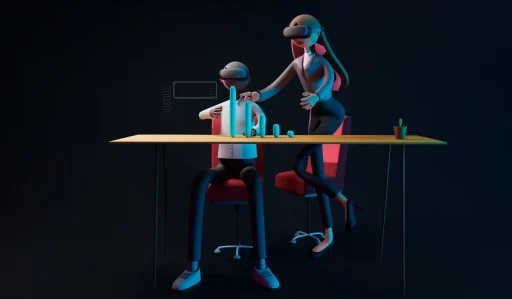If you’re new to animation, you must have heard the term “motion graphic” or “motion design.” However, most people are still confused or unsure about what it exactly means.
In simple words, when animation or movement is added to any image, text, shape, or other object, it can be described as ‘motion graphics.’ Usually, it is used for data visualization, storytelling, and content where you want maximum engagement from the audience.
When to use Motion Graphics?
Motion graphic is a great tool for engaging the audience. When you have a product or service that requires some kind of explanation, motion graphics are your go-to option. They offer an engaging way to simplify complex data and help your audience grasp it quickly.
Why motion graphics
Motion graphics can simplify complex ideas through visuals.
A few ideas (especially big, abstract ones) are hard to explain with words or static images. A short video of motion graphics can clear everything up perfectly.
Make it simple:
Motion design is used to break down complicated concepts into visually appealing content. Through text, imagery, and animation, motion graphics can streamline complex data and make it easy for audiences.
More engagement
The versatile nature of motion graphics keeps viewers hooked. With the help of compelling visuals and smooth transitions, motion graphics can hold an audience’s interest more effectively than static images or text.
Build your brand
Motion graphics offer an opportunity to reinforce brand identity through a selected theme of colors, fonts, and styles. This creates a cohesive visual language that helps strengthen brand recognition and leave a lasting impression.
Be diverse:
Motion graphics can be used across a number of platforms, from social media to proposals, and presentations, making them a useful medium for communication.
Whether you’re creating an eye-catching animation for your company’s logo or promoting a product, motion graphic is the best way to move forward.
Keeps your budget in check:
Live-action video production is pretty costly, on the contrary, motion graphics are much more cost-effective. They require fewer resources such as actors, sets, and equipment, making them a budget-friendly choice for businesses and creators.
Tell a story:
Creatives use the captivating ideas of motion graphics to tell a story. Through artistic animation and transitions, motion design conveys narratives that resonate with audiences and evoke emotions.
Like, comment, Share:
Today, content that is easy to share is the biggest factor in reaching a wider audience. Motion graphic videos are shareable on social media and other platforms, raising your chances of reaching more people and potentially going viral.
5 Steps to Getting Started with Motion Graphics
Okay, let’s talk about where to start if you’re getting into motion graphics animation. Understanding and learning the basics of any art or skill is important before you jump into it.
Study the basic principles
There are fundamentals to motion graphics that are necessary for you to study, principles such as Timing, Spacing, and Rhythm are the basics of a good motion graphics video. You can buy an online course on sites such as Coursera, Udemy, and Skillshare, or you can find free videos and courses on YouTube.
Multiple channels teach motion graphics, pick the one you like, and voila! You can learn the basics within 2 weeks, just put in the hard work.
Learn software and practice tools
You can’t dig a tunnel without learning how a shovel works, right? You must know the right software before you start the motion design. Photoshop and Illustrator are essential when you’re working on concept art, and if you’re lucky and have a background in sketching and drawing, you’ll adapt to these tools much quicker than everyone else.
You’ll also need to try different software like Blender, Adobe After Effects, Cinema 4D, Apple Motion, and more. You don’t have to master all of them, I would recommend you to try all of these and pick the one that’s most suitable for you.
Also, it’s not necessary when you’re starting but FL Studio and Pro Tools are also valuable when it comes to adding sound effects and mixing audio in your video.
Feedback
Honest feedback and constructive criticism is the backbone of all thriving artists. Especially when you’re starting out, it’s important that you receive feedback from a professional in your field. If you don’t have anyone in your circle, you can look for people on public platforms, or you can find someone on LinkedIn.
Feedback, advice, and tips will help you improve and overcome your mistakes faster. You can also show your motion graphics to your friends and family members to get an “audience” or “viewer’s perspective.
Self-learning and unique style
Once you get a hold of the fundamentals, it’s time to build your style. Every artist is unique, but when you’re starting, it’s okay to mimic the style of motion graphic you like and emulate that. But for your growth as an artist and designer, you need to build a style that’s different from others.
The market is saturated and to stand out you have to think outside the box and take creative leaps. You don’t have to stress about it in the beginning but as you start to get a hold of your brushes, you need to look for a different stroke.
Look for inspiration (browse art)
Study good art! Great art comes from finding the right inspiration at the right time. One of my favorite quotes regarding inspiration comes from none other than arguably the greatest artist of this century.
“Inspiration exists, but it has to find you working.”
― Pablo Picasso
I love this quote because it emphasizes the importance of hard work. You can be great as Picasso but even then, you have to be around the canvas honing your craft if you want to be regarded as one of the greatest in your field.
You see motion graphics everywhere
You may have not noticed before but if you pay attention, you’ll notice that motion graphics are used everywhere on digital platforms.
Let me break it down:
Explainer Videos
One of the most common uses of motion graphics is in explainer videos. Companies use motion graphics to demonstrate how their product or service works. If you get good at motion design, you will definitely get a lot of work related to explainer videos.
Branding and Animated Logos
You must have seen the animated logos, usually at the start or end of a video. Whether on TV commercials or digital advertisements, motion graphics are a great way to maintain the engagement of the viewers. These animated logos are monumental for brand identity, leaving an imprint on the viewer’s mind.
CTA’s
Call-to-actions on websites and other social platforms are in the form of animation. Moving objects, text, shapes, etc. are examples of motion graphics being used for creating interactive CTAs.
Sales and Landing Pages:
On average 9 out of 10 visitors bounce off the landing page. To fix this issue, companies are using motion graphics to keep visitors engaged. Most sales and landing pages spend a hefty budget to bring in these visitors, so it’s important that they stay on the page.
Social Media:
The social media algorithms in 2024 support videos rather than static images, therefore animated videos, including motion graphics are a big part of the marketing strategy of brands that rely on social media engagement.
Building an audience requires content that is sharable and engaging and motion graphics is the best way to do it.
Conclusion
So now that you know how to start motion graphics, it’s time for a quick recap. The first thing for you to do is research. Watch and study a lot of motion graphic videos, take a course, or learn the basics on YouTube.
Find out your inner artist, study the art, and come up with a unique style. Look for constructive criticism and feedback from experts in your industry. Find a niche, and stick to it. Find clients for that specific niche, you are more likely to be successful that way. I think that’s about it for now, good luck learning motion graphics, you’ll ace it.





